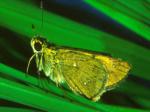Common name
Scientific name
Pelopidas mathias Fabricius, Parnara guttata Bremer and GreyWhat it does
Rice skipper feeding damage causes removal of leaf tissues. They roll leaves and make a protected chamber.
Why and where it occurs
The diverse microhabitats in upland environment are conducive to the rice skipper’s development. Droughts, downpours, floods, or misuse of pesticides are favorable for the insect because beneficial organisms, which held them in check, die.
Rice skippers are found in all rice environments. They are most abundant in rainfed rice fields. The adults are diurnal. At nighttime, they rest. They have very fast and erratic flight movement as they skip from plant to plant. The larvae are nocturnal. They feed on the leaf blades at night and rest during daytime. They also create a leaf chamber where they rest during the day.
The insect favors young transplanted rice seedlings. Feeding damage continues until plant maturation.
How to identify
Check the plant for the following symptoms:
- Removal of leaf tissues and veins and sometimes leaving only the midrib
- Rolling down of leaf tip or folding two edges of the same leaf or two adjacent leaves and tying them with silken threads to make a protective chamber
Check for presence of the larva feeding on the leaf blade:
- white spherical eggs laid singly on leaf blades
- larvae feeding on rice foliage
Click on images to enlarge
How to manage
Parasites and predators usually control the population density of rice skippers in the field.
The eggs of rice skippers are parasitized by small wasps. Big wasps and tachinid flies parasitize the larvae. They are preyed upon by reduviid bugs and earwigs. The orb-web spiders feed on the adults during flight.
A nuclear polyhedrosis virus also infects skipper larvae.
Learn more
View full fact sheet:
Rice skipper on IRRI Rice Knowledge Bank



